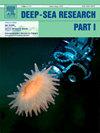Influence of the Amazon River plume on the biodiversity and assemblage structure of lanternfishes (Myctophidae)
IF 2.1
3区 地球科学
Q2 OCEANOGRAPHY
Deep-Sea Research Part I-Oceanographic Research Papers
Pub Date : 2025-08-06
DOI:10.1016/j.dsr.2025.104572
引用次数: 0
Abstract
Lanternfishes (Myctophidae) are among the most abundant vertebrates globally, playing critical roles in carbon transport, nutrient recycling, and trophic structuring of pelagic ecosystems. However, they remain poorly understood and are increasingly impacted by anthropogenic activities. Here we investigated how the plume of the world's largest river, the Amazon, shapes the diversity and assemblage structure of lanternfishes. To this end, we conducted an integrative characterization of the taxonomic diversity, distribution, and abundance of 2916 lanternfish specimens, representing 31 species, collected during the dry season (August–September 2021) across areas with varying levels of Amazon River plume influence. Based on a classification of relative importance, five species were classified as abundant and frequent, while the remaining species were predominantly classified as either scarce and frequent (nine species) or scarce and rare (17 species). In regard to vertical distribution, at least 20 of the 31 species were detected at night in epipelagic waters (0–200 m), displaying four distinct broad patterns of vertical migration and distribution. We showed that, while the Amazon Plume appears to influence lanternfish species richness and size distribution, depth is the primary variable explaining the structuring of lanternfish assemblages. Moreover, while diversity appears to be similar to other tropical regions of the Atlantic Ocean, there is a noticeable dominance of certain species, suggesting that the hydrographic structure and nutrient input from the Amazon River may favour specific species.
亚马逊河羽流对灯笼鱼生物多样性和群落结构的影响
灯笼鱼是全球数量最多的脊椎动物之一,在中上层生态系统的碳转运、养分循环和营养结构中起着至关重要的作用。然而,对它们的了解仍然很少,而且越来越多地受到人为活动的影响。在这里,我们研究了世界上最大的河流亚马逊河的羽流是如何塑造灯笼鱼的多样性和组合结构的。为此,我们对2916个灯笼鱼标本的分类多样性、分布和丰度进行了综合表征,这些标本代表31个物种,收集于干季(2021年8月至9月),分布在亚马逊河羽流影响程度不同的地区。根据相对重要性的分类,5种物种被划分为丰富和频繁,其余物种主要被划分为稀缺和频繁(9种)和稀缺稀有(17种)。在垂直分布方面,31种中至少有20种在夜间出现在0 ~ 200 m的上层水域,呈现出4种明显的垂直迁移和分布格局。我们发现,虽然亚马逊羽流似乎影响了灯笼鱼的物种丰富度和大小分布,但深度是解释灯笼鱼组合结构的主要变量。此外,虽然多样性似乎与大西洋其他热带地区相似,但某些物种明显占优势,这表明亚马逊河的水文结构和营养输入可能有利于特定物种。
本文章由计算机程序翻译,如有差异,请以英文原文为准。
求助全文
约1分钟内获得全文
求助全文
来源期刊
CiteScore
4.60
自引率
4.20%
发文量
144
审稿时长
18.3 weeks
期刊介绍:
Deep-Sea Research Part I: Oceanographic Research Papers is devoted to the publication of the results of original scientific research, including theoretical work of evident oceanographic applicability; and the solution of instrumental or methodological problems with evidence of successful use. The journal is distinguished by its interdisciplinary nature and its breadth, covering the geological, physical, chemical and biological aspects of the ocean and its boundaries with the sea floor and the atmosphere. In addition to regular "Research Papers" and "Instruments and Methods" papers, briefer communications may be published as "Notes". Supplemental matter, such as extensive data tables or graphs and multimedia content, may be published as electronic appendices.

 求助内容:
求助内容: 应助结果提醒方式:
应助结果提醒方式:


